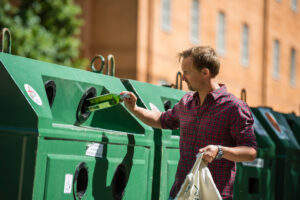Almost everything we consume will one day become waste. At current rates of consumption and growth, waste streams are set to rise substantially.
In recent decades, waste management practices have made considerable progress. As more goals, policy instruments, and measures have been introduced, public environmental awareness has increased. Waste is no longer seen as merely garbage but as a valuable resource.
In Sweden, an important task is to identify obstacles and opportunities for more sustainable consumption and to correlate behaviour with waste management planning. Waste prevention, reuse and reparation are the primary measures when it comes to waste management. Waste affects everyone and households, as well as industry and municipalities, can contribute to decreasing the amount of waste and recycle and reuse the waste created.
Household awareness a major part of the success

Image by Helena Wahlman/imagebank.sweden.se
Material recycling is the top priority and source separation of waste is made in an absolute majority of the Swedish households. The awareness and dedication of the citizens of Sweden are key success factors that have led Sweden to be considered one of the global leaders in sustainable waste management.
Most households in Sweden separate its waste into the following fractions: Food waste, packaging of metal, plastic, paper and glass, newspapers, electronics, tires and batteries. Important steps to increase reuse and repair of goods are currently taken. Extended producer responsibility creates incentives for the producer to decrease waste generation and increase material recycling.
Waste-to-energy
A large share of the waste generated in Sweden is incinerated in waste-to-energy facilities, where water for district heating as well as electricity is generated. As a result of all measures taken, less than one percent of the total waste generated in the country is put on landfills. Urban planning is an important tool when municipalities want to work to treat waste according to the waste hierarchy.
Waste management in Swedish law
The legal basis for the Swedish waste management system is established by both Swedish and European waste legislation. In Sweden, the least preferred solution is the disposal of waste at landfills. The most favorable option is to prevent waste generation and reuse and repair products. If waste is still generated, the key target is to recycle the materials.
Overall milestones of the development of Swedish waste management
- Producer responsibility was first introduced in 1994. Currently, eight product groups are included. The most important of these are packaging, newspapers, tires, cars, batteries, and electrical and electronic waste.
- Landfill tax (1999) and bans on landfilling of combustible waste (2002) and organic waste (2005).
- Ambitious targets for material recycling.
- EU membership has meant more stringent standards for hazardous waste, landfill, and incineration.
Economical incentives
- 2000 the landfill tax for diversion of municipal waste from landfills in favor of recycling and incineration. Landfill taxation levels increased in 2002, 200,3 and finally in 2006.
- A weight-based charge is applied to household waste, giving citizens an incentive to increase recycling of packaging waste.
- Taxation on the burning of fossil fuels.
- Municipal waste management.
- Extended producer responsibility.
- No taxation on biogas.
Judicial and regulatory incentives
- 1999 Environmental Code and the EU’s waste hierarchy.
- Since the 1990s extended producer responsibility for packaging waste – Paper waste- Electrical and electronic waste – Batteries – Tires – End-of-life vehicles – Pharmaceuticals – Radioactive products/unclaimed radioactive sources.
- 2002 landfill ban on sorted combustible waste.
- 2005 landfill ban on organic waste.
- 2010 regulations of municipal waste management plans in every municipality called “Waste Plan 2020”.
- The environmental objectives (national, regional and local) adopted by the government 1999 set by the Swedish government. In 2005 include, among others, the target of 50 % recycling of household waste by 2010.
- 2015 EU’s Circular Economy Action Plan.
- 2018-2023 Waste Plan and waste prevention programs in Sweden.
Information to citizens to change behavior
In Sweden, environmental problems need to be tackled now, and not passed on to future generations. That is the thinking behind Sweden’s environmental objectives – goals that are crucial to welfare and intended to guide the sum total of Swedish efforts to safeguard the environment. The milestone targets indicate the steps along the way to the environmental quality objectives and the generational goal. Referring to waste, measures must be taken to achieve better resource management, including:
- Better resource management in the food chain:
Measures are to be taken so that resource management in the food chain is improved through separation and biological treatment of at least 50 percent of food waste from households, catering services, shops and restaurants, with the aim of recovering plant nutrients, with at least 40 percent treated in such a way that energy is also recovered. - Construction and demolition waste:
Measures are to be taken so that at least 70 percent by weight of non-hazardous construction and demolition waste is prepared for reuse, recycling, and other material recovery.